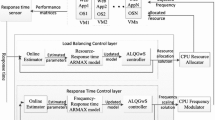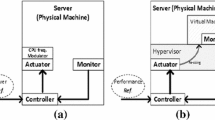Abstract
In recent years, power saving problem has become more and more important in many fields and attracted a lot of research interests. In this paper, the authors consider the power saving problem in the virtualized computing system. Since there are multiple objectives in the system as well as many factors influencing the objectives, the problem is complex and hard. The authors will formulate the problem as an optimization problem of power consumption with a prior requirement on performance, which is taken as the response time in the paper. To solve the problem, the authors design the adaptive controller based on least-square self-tuning regulator to dynamically regulate the computing resource so as to track a given reasonable reference performance and then minimize the power consumption using the tracking result supplied by the controller at each time. Simulation is implemented based on the data collected from real machines and the time delay of turning on/off the machine is included in the process. The results show that this method based on adaptive control theory can save power consumption greatly with satisfying the performance requirement at the same time, thus it is suitable and effective to solve the problem.
Similar content being viewed by others
References
Koomey J, Growth in data center electricity use 2005 to 2010, Analytics Press, Oakland, CA, August 1, 2011: 2010, http://www.analyticspress.com/datacenters.html.
Wen C, He J, Zhang J, and Long X, PCFS: Power credit based fair scheduler under DVFS for muliticore virtualization platform, Proceedings of 2010 IEEE/ACM International Conference on Green Computing and Communications and International Conference on Cyber, Physical and Social Computing, Hangzhou, China, 2010.
Xu W, Zhu X, Singhal S, and Wang Z, Predictive control for dynamic resource allocation in enterprise data centers, Proceedings of the 10th IEEE/IFIP Network Operations and Management Symposium, Vancouver, Canada, 2006.
Wang Y, Wang X, Chen M, and Zhu X, Power-efficient response time guarantees for virtualized enterprise servers, Proceedings of the 29th Real-Time Systems Symposium, Barcelona, Spain, 2008.
Lim H, Kansal A, and Liu J, Power budgeting for virtualized data centers, Proceedings of 2011 USENIX Annual Technical Conference, Portland, OR, USA, 2011.
Kusic D, Kephart J O, Hanson J E, Kandasamy N, and Jiang G, Power and performance management of virtualized computing environments via lookahead control, Cluster Computing, 2009, 12(1): 1–15.
Wang X and Chen M, Cluster-level feedback power control for performance optimization, Proceedings of the 14th IEEE International Symposium on High Performance Computer Architecture, Salt Lake City, UT, USA, 2008.
Vengerov D, A reinforcement learning approach to dynamic resource allocation, Engineering Applications of Artificial Intelligence, 2007, 20(3): 383–390.
Xu J and Fortes J, Multi-objective virtual machine placement in virtualized data center environments, Proceedings of 2010 IEEE/ACM International Conference on Green Computing and Communications and International Conference on Cyber, Physical and Social Computing, Hangzhou, China, 2010.
http://www.spec.org/power_ssj2008/results/res2010q4/power_ssj2008-20100921-00294.html.
Kalman R E, Design of a self-optimizing control system, Trans. ASME, 1958, 80: 468–478.
Astrom K J and Wittenmark B, On self-tuning regulators, Automatica, 1973, 9: 185–199.
Guo L and Chen H F, The Astrom-Wittenmark self-tuning regulator revisited and ELS-based adaptive trakers, IEEE Trans. Automatic Control, 1991, 36(7): 802–812.
Guo L, Further results on least square based adaptive minimum variance control, SIAM J. Control and Optimization, 1994, 32(1): 187–212.
Guo L, Convergence and logarithm laws of self-tuning regulators, Automatica, 1995, 31(3): 435–350.
Astrom K J, Theory and appliction of adaptive control-a survey, Automatica, 1983, 19: 471–486.
Kan R, Adaptive switching control of discrete time nonlinear systems, Journal of Control Theory and Applications, 2004, 2: 43–50.
Ma H, Finite-model adaptive control using LS-like algorithm, International Journal of Adaptive Control and Signal Processing, 2006, 21(5): 391–414.
Ljung L, System Identification: Theory for the User, 2nd Edition, John Wiley and Sons, Inc., New Jersey, 1999.
Guo L, Self-convergence of weighted least-squares with applications to stochastic adaptive control, IEEE Trans. Automatic Control, 1996, 41(1): 79–89.
Box G E P, Jenkins G M, and Reinsel G C, Time Series Analysis: Forecasting and Control, 4th Edition, John Wiley and Sons, Inc., New Jersey, 2008.
Kumar P R, Convergence of adaptive control schemes using least-squares parameter estimates, IEEE. Trans. Automatic Control, 1990, 35: 416–423.
Ma H, Lum K Y, and Ge S S, Decentralized Astrom-Wittenmark self-tuning regulator of a multi-agent uncertain coupled ARMAX system, Proceedings of 2007 IEEE Multi-Conference on Systems and Control, Singapore, 2007.
Ma H, Decentralized adaptive synchronization of a stochastic discrete-time multi-agent dynamic model, SIAM J. Control and Optimization, 2009, 48(2): 859–880.
Ma H, Ge S S, and Lum K Y, WLS-based partially decentralized adaptive control for coupled ARMAX multi-agent dynamical system, Proceedings of 2009 Americal Control Conference, St. Louis, Missouri, USA, 2009.
Author information
Authors and Affiliations
Corresponding author
Additional information
This research was supported by the National Natural Science Foundation of China under Grant No. 61304159.
This paper was recommended for publication by Editor DAI Yuhong.
Rights and permissions
About this article
Cite this article
Wen, C., Long, X. & Mu, Y. Dynamic power saving via least-square self-tuning regulator in the virtualized computing systems. J Syst Sci Complex 28, 60–79 (2015). https://doi.org/10.1007/s11424-014-2118-9
Received:
Revised:
Published:
Issue Date:
DOI: https://doi.org/10.1007/s11424-014-2118-9




